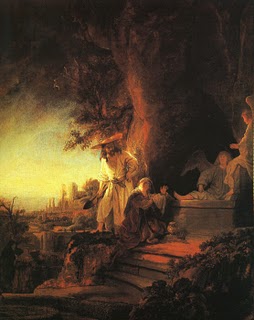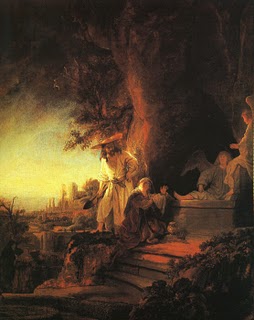“He is not here… He is risen!†These are the words the angels will use this morning to announce the Resurrection to the women. “He is not here… He is risen!†But what will these few words allow the women to believe? How will this short sentence allow them to pass from sorrow into hope? How will these words of the angels “He is not here… He is risen!†make it possible for them to hope again in life after the immense sorrow they had just passed through?
Indeed, these women’s sorrow was immense and, crushed by this sorrow, they came to the tomb on that early dawn, which would be Easter. They were crushed, indeed, for they had seen the Master, the Lord, Jesus. They had followed him. They had listened to him speak of the goodness of the Father. They had heard him speak to all people, starting from the little ones. They had seen him raise the little ones, and then speak to the learned, to the powerful and tell them that they were wrong to think that, because they thought that they knew God, they could exercise power over the little ones, and tell them what they should know about God and somehow impose on them a way of life. The learned, the powerful had believed that they possessed God. They thus dispossessed the little ones of God. And when the powerful and the learned heard the Son of man, the One who spoke of the Father challenge their words, they arrested him, and then they silenced Him. And then they killed Him!
And the women had seen all this and it is in this sorrow that, on that morning, they came to the tomb in silence, crushed. They wanted to render a last homage to the body of him whom they had followed, the one they loved. And in that silence, suddenly, the angels speak: “He is not here, He is risen. Remember… He told you, He promised you!†All of a sudden the silence is no longer one of absence, an oppressive silence, the sort of silence in which one can say that one is all alone and from which there is no way out. All of a sudden, silence is the lace of the Word. The Word the authorities had wanted to silence resounded anew. This Word is the promise of life above all, of life for all starting from the little ones, starting from those whom people wanted to silence, starting from those that are marginalized. This Word was given to them. From then on, silence was the place where the women listened to the Word of God. Then they looked at the tomb, and the tomb was empty! This empty tomb is a curious sign that speaks of Resurrection. Often, indeed, we do not like emptiness, it frightens us, and it offers no future. Sometimes it makes us believe that nothingness, death, and anguish can take man and enclose him once and for all. We do not like emptiness.
The women looked and the tomb was empty… “He is not here†… From the empty tomb the women understood that it was not an absence that they had to witness, on the contrary, it was the rising of the One who had been crushed by death. It is a new presence that will spring from the empty tomb. The women, then, understood that, contrary to the emptiness that comes from nothingness and death, there was an absence that attracted them to life, a presence that would walk with them for all their life. Silence was inhabited by the Word. Emptiness was filled by the dense presence of The One they loved and that they can love again. But this tomb, like all tombs, was somber, and so, beside the tomb they saw the clothes of the angels, and the Gospel tells us that their vestments were shining with light.
This is Resurrection! We often believe that death, darkness, impasses will have the upper hand on our plans, our projects, and sometimes even on our hope. We often think that everything that darkens the horizon, darkens the world … we will never get out of this! We often think that our destiny is darkness, rather than light. The angels’ clothes are there, and they speak to us, as in the novel by Yasmina Cadra, “What the Day owes the Nightâ€. Night is the crushing of Jesus in death, a crushing from which He rose again. The day is the light of this rising. The angels’ clothes signify that it was necessary for him to pass through death to be crushed and then to live again: He is risen!
When we sometimes think about our resurrection, we imagine that it is for the future, for later on. That resurrection is the future we are promised is true. But today, together with the women by the tomb, we have to believe strongly, otherwise… or better! Resurrection is not something for later on.
Resurrection is first of all that of Christ, and our life begins with the resurrection of Christ.
This is the message of the empty tomb: our life begins with the Resurrection of Christ. The silences that prevent us from telling our story and from believing in ourselves, the silences that enclose us in ourselves, these silences are now inhabited by the life of Christ, arisen from the dead. Emptiness, anguish, the loss of hope which mark our life, because life is difficult … this emptiness, is suddenly filled by a presence, the presence of the living One, He who is our life. The obscurities, those things that sometimes make us stammer and stumble in life … the deaths, the ordeals we face, what makes us think that death is the end of everything, all of this, today on this Easter morning is illumined by the light of Christ. Yes, He is risen, He is no longer here.
He is risen! And where is He? He is in your life, in the life of each one of us; in the midst of our silences and of our words, in the midst of our words and of our obscurities, in the midst of our relations and of our loneliness. He is life!
Saint Paul said, “For me to live is Christâ€. For us, on this Easter morning, life is the life of the Risen Christ.
Happy Easter !!!
Fr. Bruno Cadore, OP
Master of the Order of Preachers
April 23, 2011
From the Gospel of St. Luke proclaimed during Easter, Bruno Cadoré, Master of the Order of Preachers meditates on the words of the angels: “He is not here, He is risenâ€. Beside the empty tomb the women who received this message were able to hope again, and we with them for life begins with the Resurrection of Christ.


